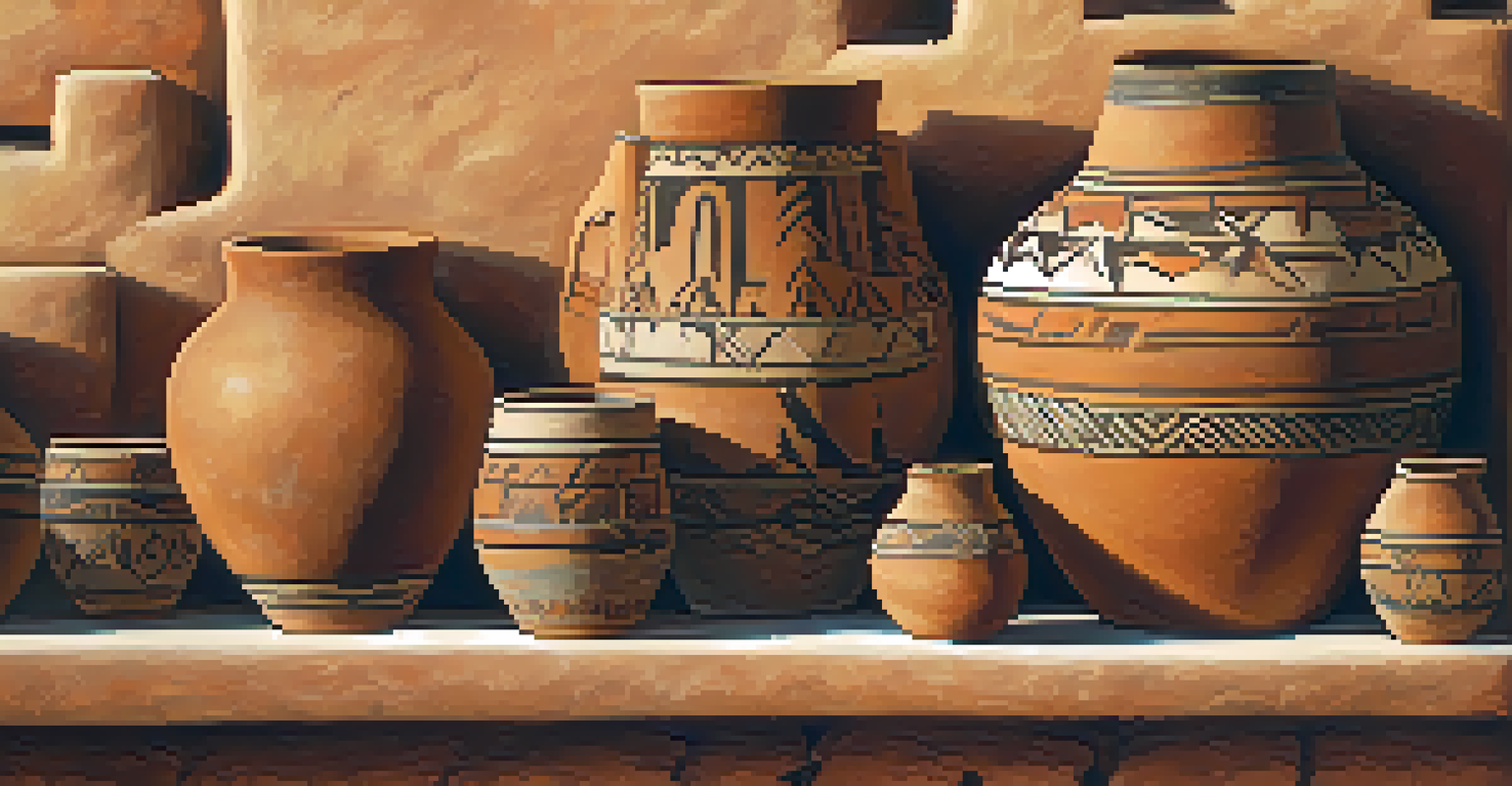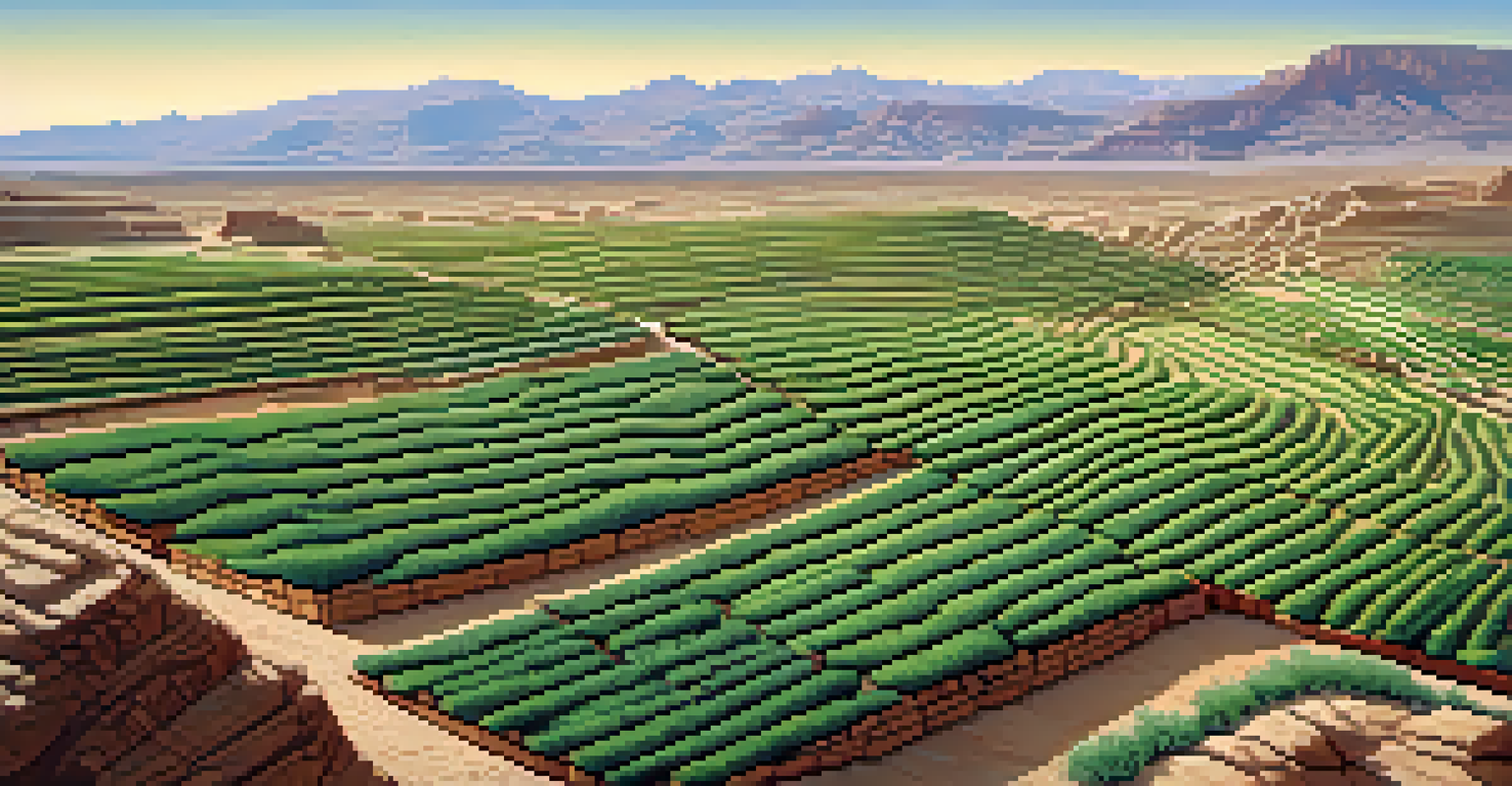The Ancestral Puebloans: Arizona's Early Indigenous Cultures

Understanding the Ancestral Puebloans and Their Origins
The Ancestral Puebloans, often referred to as the Anasazi, were a group of Indigenous peoples who thrived in the Southwestern United States, particularly in present-day Arizona, New Mexico, Colorado, and Utah. Their story begins around 100 AD, when they transitioned from a nomadic lifestyle to one of agriculture and permanent settlements. This shift allowed them to cultivate crops like corn, beans, and squash, laying the foundation for their complex societies.
The land is sacred. It is the source of life, and it is the responsibility of each generation to care for it.
As they developed, the Ancestral Puebloans became known for their innovative farming techniques, including the use of irrigation systems that maximized their water resources in arid landscapes. This ingenuity not only supported their growing population but also set the stage for their impressive architectural achievements. Their ability to adapt to their environment is a testament to their resilience and creativity.
Over the centuries, the Ancestral Puebloans established sophisticated societies characterized by elaborate communal structures, trade networks, and rich cultural traditions. Understanding their origins provides essential context for appreciating the complexities of their civilization and the impact they have had on Arizona's history.
Key Achievements in Ancestral Puebloan Architecture
One of the most striking aspects of Ancestral Puebloan culture is their architectural prowess. They are renowned for their cliff dwellings and multi-story stone buildings, particularly in places like Canyon de Chelly and Mesa Verde. These structures were not only practical, providing shelter from the elements, but also served as communal spaces that fostered social interaction and cultural exchange.

The design of these buildings reflects a deep understanding of the surrounding environment, utilizing natural materials such as sandstone and adobe. The iconic cliff dwellings, often built into the sides of canyons, offered protection from enemies and harsh weather. This architectural style has captivated historians and tourists alike, showcasing the Ancestral Puebloans' ingenuity and adaptability.
Ancestral Puebloans and Agriculture
The Ancestral Puebloans developed advanced agricultural techniques that allowed them to thrive in arid environments, forming the backbone of their society.
In addition to their impressive dwellings, the Ancestral Puebloans also built ceremonial structures known as kivas. These circular rooms played a crucial role in their spiritual practices and community gatherings, highlighting the importance of religion and social cohesion in their culture. The architectural legacy of the Ancestral Puebloans continues to influence modern designs and is a source of pride for Indigenous communities today.
The Role of Agriculture in Ancestral Puebloan Society
Agriculture was the backbone of Ancestral Puebloan society, shaping their daily lives and social structures. The cultivation of crops such as corn, beans, and squash, often referred to as the 'Three Sisters,' provided the nutritional foundation for their communities. The agricultural calendar dictated their rhythms of life, from planting to harvest, creating a sense of unity and shared purpose.
We do not inherit the Earth from our ancestors; we borrow it from our children.
Innovative farming techniques, such as dryland farming and the construction of terraced fields, allowed them to thrive in the challenging desert environment. They also developed sophisticated irrigation systems that enabled them to divert water from rivers and streams, maximizing their crop yields. This ingenuity not only ensured food security but also facilitated trade with neighboring cultures.
The impact of agriculture extended beyond sustenance; it influenced societal organization and cultural practices. As communities grew, so did the need for cooperation and social structures, leading to the emergence of leadership roles and trade networks. Understanding the importance of agriculture helps us appreciate how the Ancestral Puebloans built thriving societies in a seemingly inhospitable landscape.
Ancestral Puebloan Cultural Practices and Beliefs
Cultural practices and beliefs were central to the identity of the Ancestral Puebloans, shaping their worldview and daily interactions. They held a deep connection to the land, which was reflected in their spiritual beliefs and rituals. Nature played a significant role in their cosmology, with various elements viewed as sacred, influencing their agricultural practices and communal activities.
Ceremonies often revolved around the changing seasons, emphasizing the cyclical nature of life. For instance, harvest festivals celebrated the bounty of crops and reinforced community ties. Artistic expressions, such as pottery and weaving, also served as both functional items and means of storytelling, preserving their history and traditions for future generations.
Innovative Ancestral Architecture
Their architectural achievements, including cliff dwellings and kivas, showcase their ingenuity and deep understanding of their environment.
Understanding these cultural practices provides insight into the values that guided Ancestral Puebloan life. Their emphasis on community, spirituality, and respect for nature continues to resonate with Indigenous cultures today, highlighting the enduring legacy of their beliefs and practices.
Trade Networks and Interactions with Neighboring Cultures
The Ancestral Puebloans were not isolated; they engaged in extensive trade networks that connected them with neighboring cultures across the Southwest. This exchange of goods, ideas, and technologies fostered cultural diversity and innovation. Items such as turquoise, pottery, and woven textiles were highly valued and often traded for essential resources like food and raw materials.
Trade routes facilitated not only the movement of goods but also the flow of information. Through these interactions, the Ancestral Puebloans adopted new agricultural techniques and artistic styles, enriching their own cultural practices. This interconnectedness illustrates the dynamic nature of their society and the importance of collaboration across different communities.
Additionally, these trade relationships played a vital role in their survival, allowing them to access resources that were scarce in their own environment. The ability to adapt and incorporate new ideas from other cultures contributed to their resilience and longevity, showcasing the significance of trade in shaping Ancestral Puebloan civilization.
The Decline of the Ancestral Puebloan Civilization
Despite their remarkable achievements, the Ancestral Puebloan civilization faced significant challenges that ultimately led to their decline in the late 13th century. A combination of factors, including prolonged drought, resource depletion, and social unrest, contributed to the collapse of their communities. These environmental and societal pressures forced many groups to abandon their homes and migrate to more hospitable areas.
Archaeological evidence suggests that the droughts experienced during this period were severe, impacting agricultural production and leading to food shortages. As resources became increasingly scarce, competition for land and water intensified, creating tensions within and between communities. This perfect storm of challenges ultimately strained their social fabric and resulted in widespread displacement.
Cultural Legacy and Modern Influence
The enduring legacy of the Ancestral Puebloans is reflected in contemporary Indigenous cultures, highlighting the importance of preserving their history and traditions.
Understanding the decline of the Ancestral Puebloans is essential to appreciating the complexities of their civilization. Their story serves as a reminder of the fragility of human societies in the face of environmental changes, and it highlights the importance of sustainable practices that can help us learn from the past.
The Legacy of the Ancestral Puebloans Today
The legacy of the Ancestral Puebloans continues to be felt in contemporary Indigenous cultures and communities. Their descendants, including the Hopi and Zuni peoples, carry forward traditions, languages, and practices that trace back to their Ancestral Puebloan ancestors. This connection to the past is a source of pride and identity, reinforcing the importance of cultural heritage.
Efforts to preserve and protect archaeological sites, such as Chaco Canyon and Mesa Verde, highlight the ongoing significance of Ancestral Puebloan culture. These sites serve not only as reminders of their achievements but also as educational resources for future generations. By sharing their history and traditions, Indigenous communities strive to keep their rich heritage alive in a rapidly changing world.

In exploring the Ancestral Puebloans' contributions, we gain a deeper understanding of the resilience of Indigenous cultures. Their ability to adapt, innovate, and connect with their environment continues to inspire us, reminding us of the value of respecting and learning from our shared history.